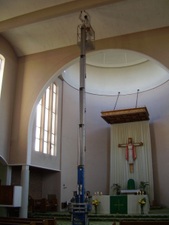Asbestos - An unholy problem?
 Hailed as the wonder building material when first used in the 1890’s and reaching its peak use in buildings around the mid 1970’s it’s not unreasonable to find asbestos used extensively in schools and churches. Asbestos containing materials take on many forms and have many uses in construction from simple floor tiles to board materials, anti-condensation products and of course thermal insulation.
Hailed as the wonder building material when first used in the 1890’s and reaching its peak use in buildings around the mid 1970’s it’s not unreasonable to find asbestos used extensively in schools and churches. Asbestos containing materials take on many forms and have many uses in construction from simple floor tiles to board materials, anti-condensation products and of course thermal insulation.
Right – Tersus Surveyor taking samples of sprayed asbestos.
So good was asbestos that asbestos containing materials could be mixed with other materials to produce rigid materials which could be moulded, formed, compressed, machined or just be used in its raw fibrous state as pipe and boiler insulation or sprayed onto surfaces as an asbestos coating.
Tradesmen became so adept at working with asbestos they produced mini works of art, one can only admire the perfect roundness of hand applied pipe insulation in many, still operating boiler houses or the alabaster type finish they managed to apply to sprayed coatings to the soffits of commercial offices, department stores, hotels, hospitals, schools and churches.
The thing is of course, it is very difficult to know what is asbestos and what is not and this why the largest group at risk from asbestos is currently tradesmen and why around 5000 people per year die from asbestos related diseases. Asbestos was finally prohibited in the UK in 1999.
Who would have thought the ‘decorative’ finish to the underside of a church roof in Yorkshire was asbestos.
Over the years, water penetration had caused the surface of the asbestos coating to deteriorate and even start to delaminate in certain areas causing the risk of asbestos fibres being released to increase dramatically. The only option was to remove the problem area and to fully encapsulate the remainder.
 Right – damage to sprayed asbestos coating visible either side of the lower roof valley.
Right – damage to sprayed asbestos coating visible either side of the lower roof valley.
The asbestos was found to be clearly marked on the original architects drawings for the church but for some reason did not appear on the asbestos register. It was clear that a definitive asbestos survey was required in order to fully locate the presence, condition and location of any asbestos containing materials.
Access to the high level areas was extremely difficult as elevating equipment had to be sourced that would fit through a standard door and be capable of reaching the height required. Following a thorough site inspection it was possible to formulate an asbestos management plan and confirm that all areas with the exception of the two areas of low level roof were sound, well encapsulated and posed a manageable risk.
The recommendation therefore was the removal of the whole of the sections of roof containing the damaged areas and to commence an air monitoring regime within the church in order to check the airborne fibre concentration of the remainder of the building. This was to prove the building continued to be safe for occupation by unprotected people after the removal works.

Asbestos removal works presented their own problems. Firstly the removal contractor had to be carefully selected to ensure they had the experience to deal with this type of asbestos material and who could approach the works in a sympathetic manner given the nature of the building.
The other problem was that the church was regularly used allowing only 7 days to complete the work between weddings. The removal of this type of asbestos, commonly known as limpet, is notoriously difficult as the individual asbestos fibres adhere to any rough surface; the material is also extremely friable and capable of releasing fibres many thousands of times above the control limit.
Under these circumstances fibre suppression is all important, not only for the safety of the operatives but to reduce the amount of free fibre when the area is finally cleaned and decontaminated.
To cope with the very rough surface the underside of roof was hand painted with an asbestos encapsulation product to lock down any residual fibres prior to being plaster rendered and redecorated by other tradesmen to match other areas.
The Control of Asbestos Regulations 2006 soon to be replaced by CAR 2012 requires all duty-holders to formulate an asbestos management plan for the property for which they are responsible. The starting point for this plan is an Asbestos Survey Report in accordance with HSG 264 preferably by a UKAS accredited consultancy to ISO/IEC 17020.
For further information please visit us www.tersusgroup.co.uk
By Alan Peck of Tersus Consultancy.













